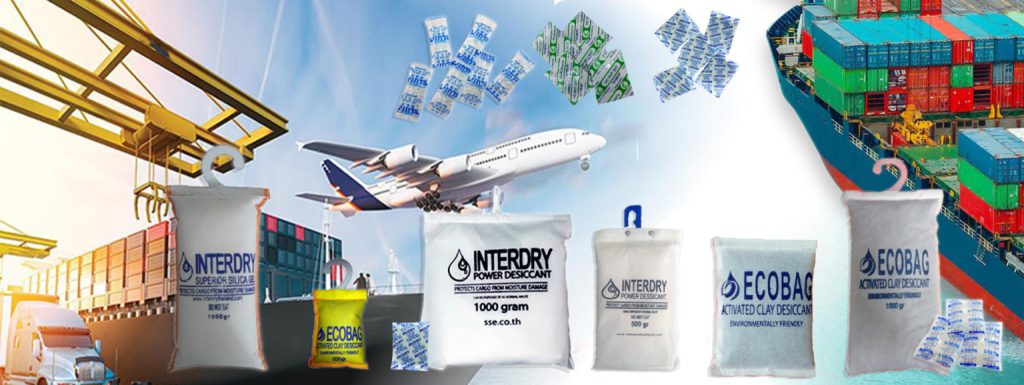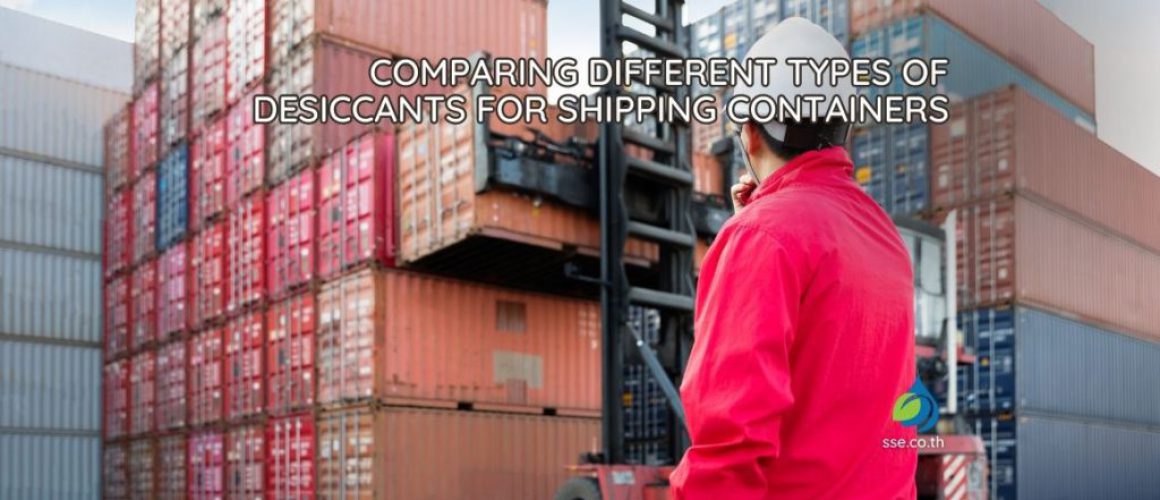Comparing Different Types of Shipping Container Desiccants


Table of Contents
Comparing Shipping Container Desiccants, Preventing Condensation in Shipping Containers.
Protecting cargo from moisture damage during transportation and preventing damp containers is of paramount importance, especially when shipping goods in containers. One effective way to achieve this is by using desiccants, which are substances that absorb moisture from the surrounding environment. This article will compare various types of desiccants used in shipping containers and discuss their effectiveness in protecting cargo from moisture damage. Choosing desiccant bags for shipping containers to prevent moisture damage inside shipping containers can be a daunting task.
.
Star Ratings for Shipping Container Desiccant Types
| Desiccant Type | Moisture Absorption | Temperature Resistance | Cost Effectiveness | Overall Rating |
|---|---|---|---|---|
| Silica Gel | ★★★ | ★★★ | ★★★★ | ★★★ |
| Calcium Chloride | ★★★★★ | ★★ | ★★★★ | ★★★★★ |
| Activated Carbon | ★★ | ★★★ | ★★★ | ★★ |
| Clay Desiccants | ★★★ | ★★★ | ★★★★ | ★★★★ |
| Molecular Sieve | ★★★★ | ★★★★ | ★★ | ★★★ |
| Activated Alumina | ★★★ | ★★★★ | ★★★ | ★★★ |
.
Silica Gel ★★★
A. Properties and Benefits
Silica gel is a popular desiccant made from silicon dioxide. It is highly porous, allowing it to absorb moisture effectively. One of the main benefits of silica gel is its ability to maintain its shape even when saturated with water. This makes it an excellent choice for protecting delicate items and ensuring that no physical damage occurs due to moisture absorption.
B. Common Applications
Silica gel is commonly used in the packaging of electronics, pharmaceuticals, and food products. Its ability to protect these items from moisture damage makes it an invaluable resource for industries that require optimal storage conditions.
Calcium Chloride ★★★★★
A. Properties and Benefits
Calcium chloride is a highly effective desiccant due to its hygroscopic properties, which means it readily absorbs moisture from the air. It can absorb up to several times its weight in water, making it one of the most potent desiccants available. In addition, calcium chloride can effectively reduce the relative humidity inside a shipping container, preventing the formation of condensation and subsequent moisture damage to the cargo. Calcium Chloride based shipping container desiccants are an excellent choice for preventing moisture damage inside shipping containers.
B. Common Applications
Calcium chloride desiccants are frequently used in the transportation of agricultural products, wood products, leather products, electrical goods, metal products, and textiles. Their ability to lower relative humidity levels makes them well-suited for protecting these goods from moisture-related damage during shipping.
Activated Carbon ★★
A. Properties and Benefits
Activated carbon, also known as activated charcoal, is a form of carbon that has been treated to increase its porosity, making it an effective moisture absorber. In addition to its moisture-absorbing capabilities, activated carbon is also known for its ability to adsorb impurities, such as odors and volatile organic compounds (VOCs). This dual functionality makes activated carbon an attractive option for shipping containers.
B. Common Applications
Activated carbon desiccants are commonly used in the transportation of items that are sensitive to odors and VOCs, such as clothing, leather goods, and food products. The combination of moisture and odor control provided by activated carbon helps to preserve the quality of these goods during transit.
.
Comparison of Shipping Container Desiccant Types
| Desiccant Type | Moisture Absorption Capacity | Regenerability | Typical Applications | Environmental Friendliness |
|---|---|---|---|---|
| Silica Gel | Moderate | Yes | Electronics, textiles, food | Moderate |
| Calcium Chloride | High | No | Agriculture, Wood, Leather, Metals, Electrical, Textiles | Moderate |
| Activated Carbon | Low | Yes | Odor control, air purification | Moderate |
| Clay Desiccants | Moderate | No | Pharmaceuticals, machinery, Agriculture, Electrical | High (biodegradable) |
| Molecular Sieve | High | Yes | Gases, chemicals, high-precision | Moderate |
| Activated Alumina | Moderate | Yes | Pharmaceuticals, chemicals, electronics | Moderate |
.
Clay Desiccants ★★★★
A. Properties and Benefits
Clay desiccants, often made from bentonite clay or montmorillonite clay, are a natural and environmentally friendly option for controlling moisture in shipping containers. These desiccants work by adsorbing moisture onto their surface, and they can effectively reduce the relative humidity in a container. Clay desiccants are also non-toxic and biodegradable, making them a sustainable choice for moisture control.
B. Common Applications
Clay desiccants are frequently used in the shipping of automotive parts, machinery, and metal products. Their ability to protect these items from moisture damage and corrosion makes them an important tool for industries that require corrosion prevention during transportation.
Molecular Sieve ★★★
A. Properties and Benefits
Molecular sieves are synthetically produced desiccants made from crystalline aluminosilicates. Their unique structure allows them to selectively adsorb water molecules while excluding other molecules, making them highly efficient moisture absorbers. Molecular sieves are particularly effective at very low relative humidity levels, making them suitable for situations where extreme dryness is required.
B. Common Applications
Molecular sieve desiccants are commonly used in the shipping of sensitive electronic components, pharmaceuticals, and chemicals that require exceptionally low moisture levels to maintain their integrity.
C. Limitations and Drawbacks
While molecular sieves are highly effective desiccants, they tend to be more expensive than other options, such as silica gel or calcium chloride. Additionally, their performance can be affected by the presence of certain contaminants or gases in the environment. As a result, molecular sieves may not be the best choice for all applications or budgets.
.
Comparison of Shipping Container Desiccant Properties
| Desiccant Type | Adsorption Mechanism | Temperature Resistance | Cost | Effectiveness in High Humidity |
|---|---|---|---|---|
| Silica Gel | Physical Adsorption | Moderate | Low | Moderate |
| Calcium Chloride | Chemical Absorption | Moderate | Low | Very High |
| Activated Carbon | Physical Adsorption, Chemisorption | Moderate | Moderate | Low |
| Clay Desiccants | Physical Adsorption | Moderate | Low | Moderate |
| Molecular Sieve | Physical Adsorption | High | High | High |
| Activated Alumina | Physical Adsorption, Chemisorption | High | Moderate | Moderate |
.
Activated Alumina ★★★
A. Properties and Benefits
Activated alumina is a desiccant made from aluminum oxide. It has a high surface area and porous structure, allowing it to effectively absorb moisture from the surrounding environment. Activated alumina is also resistant to thermal shock and abrasion, making it a durable option for shipping containers.
B. Common Applications
Activated alumina desiccants are often used in the transportation of pharmaceuticals, chemicals, and electronic components. These industries require stringent moisture control to ensure the quality and stability of their products during shipping.
Choosing the Right Shipping Container Desiccant
A. Factors to Consider
When selecting a shipping container desiccant, it is essential to consider several factors, including the type of cargo being transported, the environmental conditions during transportation, and the desired level of moisture control. Different desiccants have varying levels of effectiveness, and choosing the right one will depend on the specific needs of your cargo.
B. Customized Solutions
In some cases, it may be necessary to use a combination of desiccants or a custom solution to achieve optimal moisture control. Consult with a shipping container desiccant manufacturer and supplier to determine the best approach for your unique shipping requirements.
Conclusion: Protecting Your Cargo with the Right Desiccant
Ensuring the quality and safety of your cargo during transportation is of utmost importance, and selecting the right shipping container desiccant is a crucial part of this process. By understanding the various types of container desiccant bags available and their specific applications, you can make an informed decision that best meets the needs of your cargo and shipping conditions.


Frequently Asked Questions (FAQ)
What is the most effective desiccant for shipping containers?
The most effective desiccant for your shipping container will depend on the type of cargo being transported and the environmental conditions during shipping. Some common desiccants include silica gel, calcium chloride, activated carbon, clay desiccants, molecular sieves, and activated alumina. Consult with a desiccant expert to determine the best option for your specific situation.
Can desiccants be reused?
Some desiccants, such as silica gel and activated alumina, can be regenerated by heating them to remove absorbed moisture. However, this process may not be practical or cost-effective in all situations. Other desiccants, like calcium chloride, are not reusable and must be replaced once they have reached their moisture absorption capacity.
Are there environmentally friendly desiccant options?
Yes, some environmentally friendly desiccant options include clay desiccants, which are made from natural materials and are biodegradable. Additionally, reusable desiccants, like silica gel and activated alumina, can be considered more sustainable options as they can be regenerated and reused multiple times.
What is the best desiccant for shipping containers?
The best desiccant for shipping containers depends on the type of cargo, the environmental conditions, and the duration of the shipment. InterDry Power Desiccant, a calcium chloride-based desiccant, is an excellent option due to its high moisture absorption rate and effectiveness in various conditions. Ecobag is another reliable choice, offering a sustainable and efficient alternative to protect your cargo from moisture damage.
How much desiccant do I need for a shipping container?
The amount of desiccant needed for a shipping container depends on factors such as the container size, the type of cargo, and the environmental conditions. Generally, for a 20-foot container, you’ll need around 4 to 6 kg of InterDry Power Desiccant, while for a 40-foot container, you’ll need 8 to 12 kg. For optimal results, consider consulting the desiccant manufacturer’s guidelines or a cargo protection specialist.
How do you keep moisture out of a shipping container?
To keep moisture out of a shipping container, use a high-quality desiccant like InterDry Power Desiccant or Ecobag. These desiccants effectively absorb moisture, helping to maintain a suitable environment for your cargo. Additionally, ensure proper ventilation, use moisture-resistant packaging materials, and consider insulating the container if necessary.
What is the use of container desiccant?
Container desiccants are used to protect cargo from moisture damage during transportation and storage in shipping containers. By absorbing moisture from the air, desiccants help maintain optimal humidity levels, preventing issues such as mold, mildew, corrosion, and warping. High-quality desiccants like InterDry Power Desiccant and Ecobag ensure your cargo reaches its destination in the best possible condition.
Case Studies: Real-World Success Stories with InterDry Power Desiccant, Ecobag, and KeepDry
https://www.yumpu.com/en/document/view/10676010/temperature-humidity-in-ocean-containers
ขอบคุณที่ใช้เวลาอ่านบทความของเราเกี่ยวกับการป้องกันความชื้น ทางเราหวังว่าท่านจะได้รับข้อมูลที่มีคุณค่าและเป็นประโยชน์ ทางเรายินดีให้บริการการปรึกษาฟรีเพื่อพูดคุยเกี่ยวกับความต้องการของท่านและให้คำแนะนำเกี่ยวกับวิธีการป้องกันความชื้นที่กำหนดเฉพาะสำหรับคุณ โปรดติดต่อเราที่ 0858124188 เพื่อนัดหมายการปรึกษาหรือเยี่ยมชมร้านค้าของเราเพื่อค้นหาผลิตภัณฑ์ที่ช่วยป้องกันสินค้าของคุณจากความเสียหายจากความชื้น ทางเราหวังว่าจะได้รับข่าวสารจากท่านเร็วๆนี้
